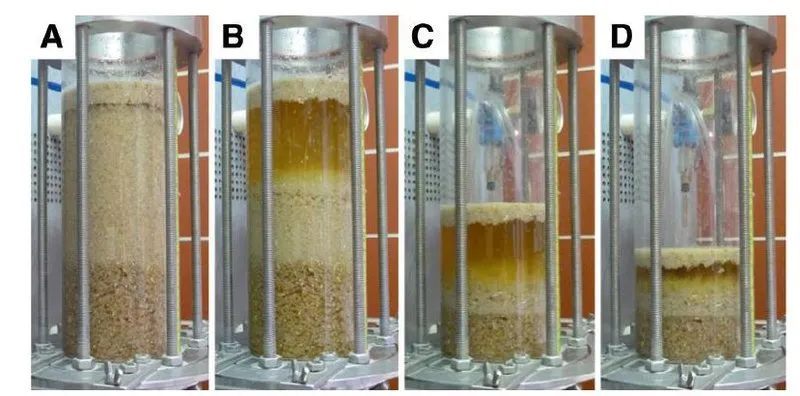ビールのロータリングという濾過工程があります きちんと発音するとラウタリングですかね Lauterはドイツ語で澄むを意味します なので濾過作業のことをlautering(ロータリング)と言います 私は日本の醸造業からキャリアをスタートしているので、ロータリングをはじめて知った時に衝撃を受けました モルトの殻でフィルターを作って綺麗な液を取り出す! なんて合理的で自然で素敵!参考までに 清酒 昔は酒袋と呼ばれる木綿の袋に入れてもろみを漉しましたが、現在ではヤブタと呼ばれる圧搾濾過で濾過します
醤油 もろみを四角い布で包んで折りたたみ、上から圧搾します
ちなみにうちのオリゼーブルーイングでは 甘酒を袋に入れて圧搾濾過します ご覧の通り、日本の伝統の醸造では全て濾過は袋での圧搾、つまりフィルターでの濾過なんです これが本当に重労働 袋や布の洗濯も大変ですし、カスをフィルターから剥がすのも大変、手も汚れる、何よりも濾過に時間がかかる! なので、オリゼーブルーイングの初期の頃 ロータリングで甘酒を濾過したい!と思い色々なフィルターを試しました その中でも、籾殻を甘酒に入れた濾過をしたことがあったのですが、籾殻が大量に必要なうえ、籾殻を通過したものは青臭い! モルティングされていない籾殻はただただ青臭く、藁の匂いがするだけ・・・ 人工的な濾過はすぐにフィルターが詰まるし・・ と散々試した結果、オリゼービールのマッシングでの濾過は大まかな布での濾過だけ。 もう濁りも一緒に発酵させてしまえ!となりました 現在ではボイル工程でも濁りがそのまま。 発酵終了後に酵母と一緒に沈殿させ、回収するという方法に落ち着いています。 なので、うちは仕込み量の10%~20%を廃棄せざるを得ません もったいないですよね モルトと麹の濾過工程における決定的な違い それが殻つきの麦のモルトに対して、精米や精麦で殻を削り取ってから麹菌を生育させる麹の違いからくる違いです もしかして、米麹のモルトならそれが可能かもしれませんね まだ、実験段階で大きな量を作っていないので、こればかりはまだわかりませんが。成功したら最高に嬉しいですが、どうなることやら There is a filtration process called "lautering" in beer production. It is pronounced as "rautering." "Lauter" means "to clarify" in German. So, the filtration process is called "lautering" or "rautering." As someone who started their career in the brewing industry in Japan, I was shocked when I first learned about lautering. Creating a filter with malt husks and extracting clear liquid! It's so rational, natural, and wonderful! For reference: Sake: In the past, the mash was strained using a cotton bag called "sakabukuro,” but nowadays it is filtered using a method called "yabuta," which is a pressure filtration process. Soy sauce: The mash is wrapped in square-shaped cloth, folded, and then pressed from the top. By the way, at our Orizae Brewing, we use bagged sweet sake and perform pressure filtration. As you can see, in traditional Japanese brewing, all filtration is done through bagging and pressure filtration, in other words, filtration through a filter. This is truly labor-intensive work. Washing the bags and cloth is a lot of work, removing residue from the filter is also challenging, and it's messy and time-consuming. Most importantly, filtration takes a lot of time! That's why, in the early days of Orizae Brewing, I wanted to filter sweet sake using lautering! So, I tried various filters. Among them, I once filtered sweet sake with rice husks, but it required a large amount of husks, and the liquid that passed through the husks had a grassy smell! Unmalted rice husks have a strong grassy smell and smell like straw... Artificial filtration clogs the filter quickly... After many trials, I found that rough filtration with a simple cloth during the mashing process of Orizae Beer is sufficient. Let the turbidity ferment together! Currently, the turbidity remains even during the boiling process. After fermentation is complete, we let it settle with the yeast and collect it. That's the method we settled on. So, we have to discard 10% to 20% of the brewing volume. It's a waste, isn't it? The decisive difference in the filtration process between malt and koji lies in the difference in koji, where malted grains with husks are used, and koji is cultivated after removing the husks through polishing or grinding. Perhaps it might be possible with rice koji malt. Since I haven't produced large quantities in the experimental stage yet, I still don't know. I would be extremely happy if it succeeds, but who knows what will happen.
ハスクとロータリングのお話し{Husks and Lautering}

